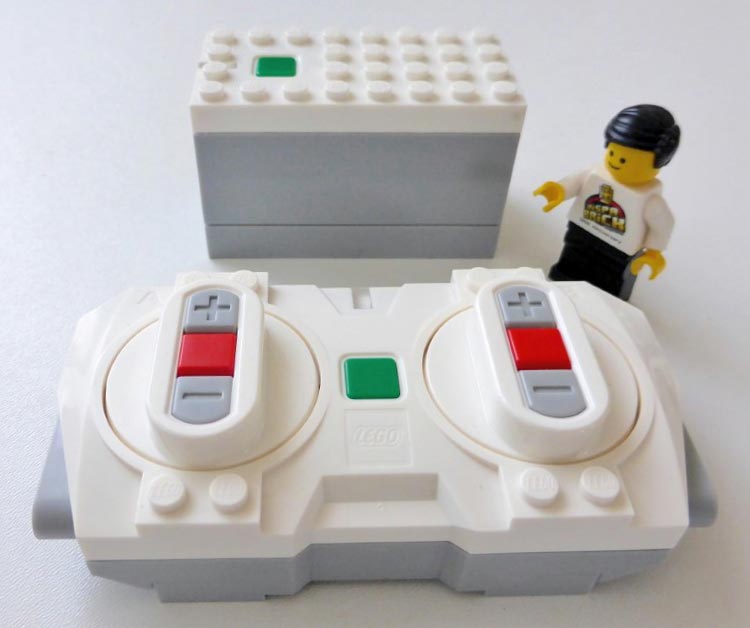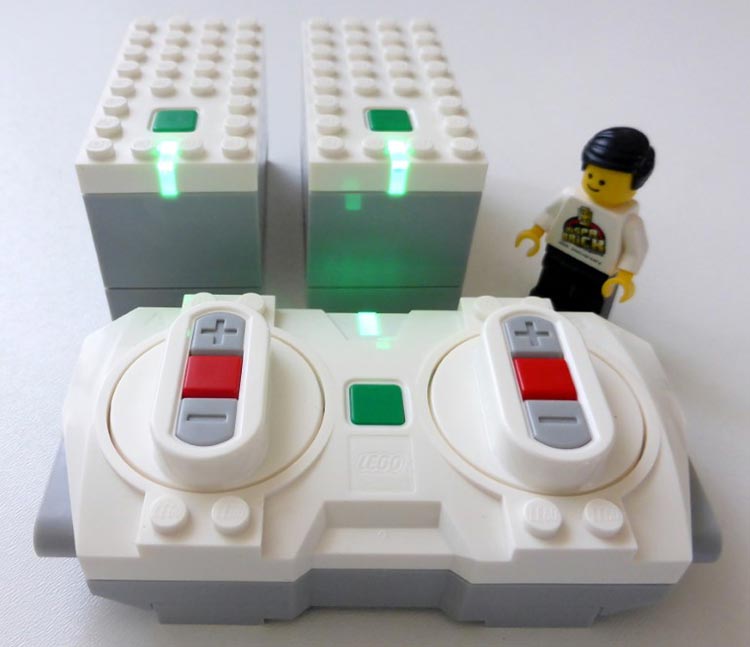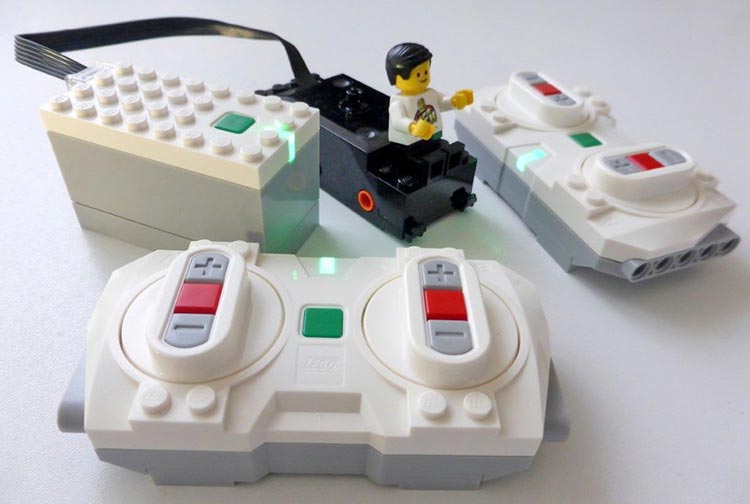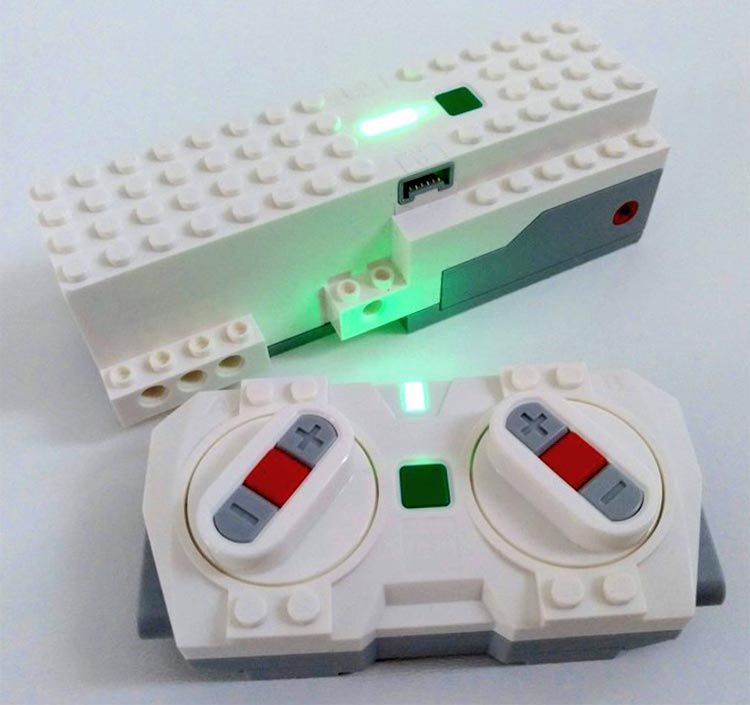Powered Up: 2 ⚡ Networks
Now that we know what Powered Up is and how the platform will extend, let’s have a closer look at the Powered Up Train Hub (or “Hub”) and some of its capabilities.
For the time being the Powered Up app can connect to a single Hub (Train Hub) or Move Hub (Boost Hub). However, if instead of the app you use the remote, several Hubs can be used together—this does not work for the Move Hub.
Pairing a remote with a hub
Pairing a remote with a hub is easy.
- Press the start button on the Hub and on the remote (one shortly after the other, it doesn’t matter in what order).
- The LED light will start blinking white, indicating they are ready to pair and looking for a connection.
- After second or two the LEDs on both the hub and the remote will turn green.
Congratulations! You have paired the hub and the remote.

Changing channels
The hub and remote con communicate with one another over 5 different channels. If you press the start button on the hub the LED colour will change and remote will follow. Each time you press the start button on the hub it will move to the next channel.
The channels are Green - Yellow - Red - Blue - Purple
Turning off o hub or remote
To turn off a hub or remote simply press the start button until the LED starts to blink white.
Controlling multiple hubs
You can control more than one hub with a single remote. In order to connect a second hub to a remote do the following:
- Press the start button on the new hub (the LED will start to blink white)
- Press the start button on the new hub and on the remote at the same time.
- You will see the new hub and the remote now have the same LED colour.
The hubs and the remote are now in the same network and (probably) on the same channel.

You can change the channel of the hub as described above: pressing the start button.
You will notice that now 2 hubs are connected, unless both hubs are on the same channel, the LED on the remote will not follow a colour change on a hub. If you put each hub on a different channel you can change the remote channel to the hub of your choice by pressing the start button. The remote will not cycle through all the existing colours, but only only through the currently connected channels.
If you want to turn off all the elements in the network, the fastest way is to turn off the remote. Once the hubs detect there is no remote they will also turn off.
Advantages of a network
After you pair one or more hubs with a remote they become part of a network and they remember their network! Try the following:
Pair 2 hubs and 1 remote.
- Set each hub to a different channel (e.g. Red and Blue)
- Turn the network off (e.g. by turning the remote off)
- Now reconnect each hub to the remote
You will notice the hubs start up with the same channel (colour) as before you turned them off (Red and Blue in this example) instead of the standard colour you would get if you pair a remote and hub that haven’t been paired before (typically Green).
Connecting two hubs on the same channel means the outputs on each hub react in the exact same way. Unfortunately there is currently no way to make the the output on one hub do the exact opposite of the output on another. That would be useful if you want to combine two passenger trains to make a single long train (in case you were wondering, turning the train motor around on the second part of the train doesn’t work as the cable gets in the way).
Setting hubs to different channels means you can control several hubs independently (e.g. different trains) sequentially from a single remote.
Connecting multiple remotes
Did you know you can also connect more than one remote to a network? So where’s the benefit in that? I asked myself the same question. So I tried some things out…
In theory Bluetooth range is better than IR range (IR is used in Power Functions). This is especially true when there is no direct line of sight or in the presence of sunlight (or fluorescent lights) which interferes with the IR signal. Bluetooth has no such limitations and doesn’t need a direct line of sight, but even so, walls and other obstacles interfere in the signal and at some point the signal is lost.
Losing the signal between the hub and the remote means the hub will stop supplying power to any motors that are attached. This is a logical behaviour as you wouldn’t want your train to crash into something (or drive off the table) just because you lost the connection.
- Connect a hub and remote
- Connect a train motor to the hub and set it to any speed
- Move the remote out of range
You will notice the LED on the remote will start blinking white and the train motor will stop.
Unfortunately this also means that at a convention you may at some point lose connection to a train at the back of the display with almost impossible access.
In comes the second remote:
- Connect two remotes to a single hub
- start the second remote by pressing the green start button
- now, press the start buttons of the hub and the second remote at the same time (for about 0.5 - 1 second)
- the LED on the second remote will turn the same colour as the hub and the second remote is now connected to the network
- Connect a train motor to the hub and set it to any speed
- Put the second remote near the hub
- Now, move the remote you used to start the train motor out of range.

The LED on the remote that is out of range will start blinking, but since there is a second remote in the network the train motor will not stop!
A practical application of this little “trick” is to add two remotes to your train layout network and place one remote near either side of the display. If any of the hubs go out of range of one of the remotes they will still be in range of the one of the others, ensuring your train will not stop somewhere at the back of your display.
Resetting a network
You can reset the individual hubs in the network after you turn them off. This way they will not remember the network they were part of anymore and can be connected to a different network.
- Press and hold the start button until the LED starts to blink purple (about 7 seconds).
Led Colour Codes
Aside from using the LED as a channel indicator, it is also used to indicate specific hub states. These states are the same across different hubs. Below is a (partial?) list of hub colours and what special states they indicate:
Fixed colours:
- channel indication (Green, Yellow, Red, Blue or Purple)
Blinking colours:
- White: hub is ready to pair and looking for other devices
- White+channel colour: connection is about to be lost (distance/obstacle/…)
- Red-Green Blue: firmware update is in progress
- Purple: network has been erased (or hub is waiting for new firmware)
- Orange: low battery
- Red: overload
Update 22 June 2019
The latest version of the Powered Up app (2.2.0) as well as the latest version of the Boost app include new firmware for the Boost hub. After this update it is possible to control the Boost hub with a remote control.

Establishing the connection is a little more difficult than connecting a single Powered Up hub to a remote. It is not enough to just press the start button on each device and wait. You need to press the start button on both devices simultaneously after starting them to establish the connection (as if the Boost hub were a second hub in an existing network).
Now you can control the internal motors (A and B in the Boost hub) with the remote control.
7546